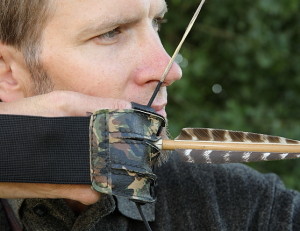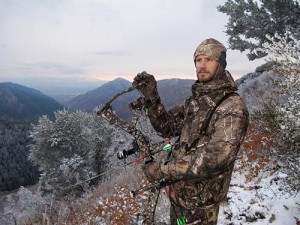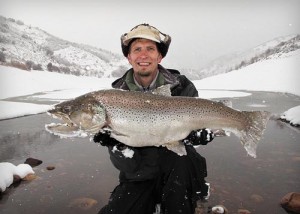
Preface: Yeah, I know this is a bowhunting blog, but fishing is hunting–underwater hunting to be exact–and many of the same hunting concepts apply.
Every Fish in Utah
Way back before video games and cell phones, when I was a little kid growing up in Northern Utah, we farm kids wiled away our time in the outdoors. Some of my earliest memories were time spent trout fishing with my family. My love for fishing continued strong into my teenage years and pretty soon I was dodging work to go fishing any time I could.
It wasn’t long before I began exploring new waters with exciting, new fish species ranging from bass, to sunfish, and weird stuff like arctic grayling and tiger musky. I guess variety truly is the spice of life because I loved catching a new fish way more than the same old boring trout.
Somewhere along my angling path I picked up a DWR fish regulation booklet in which was printed dozens of full color fish pictures. I was pleasantly surprised at just how many fish species we had living in Utah, due primarily to the wide range of temperatures and elevations this state affords. In a nanosecond I decided to catch every single fish before I died; it was my life’s goal. As an aside, I had no interest in catching the wide variety of trash fish (carp, suckers, and chubs) so I left them out.
Throughout my troublesome twenties, I systematically checked off fish after fish. It was quite the adventure. Some fish, like the white bass, pike, and tiger musky, existed in only one or two lakes, which forced me to make several surgical strikes along the way. Not only did I end up exploring countless new waters, but I was learning all about specific fish behaviors and special techniques for catching them. I talked to dozens of fish shop owners and DWR officers over the years and found the whole process to be fascinating.
Only Five to Go
As I neared my thirties, my list of remaining species had shrunk to only five species: walleye, whitefish, striped bass, and northern pike. This is where things got complicated. The DWR, in their infinite wisdom and biological prowess, began cross-breeding several species to produce entirely new species of sterile hybrids. These included tiger trout, splake, and wiper bass. It seemed that every time I crossed a fish off my list, they added a new one. It was frustrating, but fun!
The tiger trout was the craziest fish I ever met. The first one I hooked actually took of “running,” or skipping, across the lake surface. I lost several before finally landing one. There’s something about crossing a brown trout with a brook trout that brings out the crazy.

The toughest fish was the elusive walleye. This silver-eyed, nocturnal bottom-hunter exists in just a few Utah lakes, the closest being Willard Bay. For five long years I researched walleye, bought piles of walleye-specific lures, and beat the waters to death trying to catch one. I fantasized about punching the walleye in the snout if I ever did catch one. Finally, one cool and dark evening on the shores of Willard bay in 2000, I landed an 18-incher on a white curly tail jig. I didn’t punch it, but made a delicious walleye dinner instead.
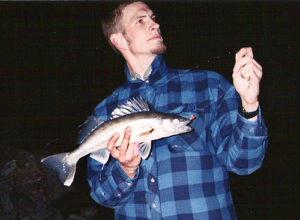
The whitefish–an ugly, bottom-feeding fish resembling a cross between a trout and a carp–fell next to my fly rod on the Weber River. One freezing, winter afternoon I bounced a nymph along the bottom and BOOM, caught and photographed a whitefish, then tossed it back. Only two fish left!
The Lowly Burbot
Nope, make that three… Around this time, some ass-clown, bucket-biologist tossed a ling cod (aka burbot) into Flaming Gorge and it just took off. This ugly fish, which resembles a cross between a snake and a living turd, exploded in the vast waters of the Gorge and now threatens to wreck the entire fishery. Nonetheless, it was placed on my hit list. In the winter of 2011 I signed up for the Burbot Bash Fish Derby and caught an ugly burbot the first night out. I almost didn’t want to touch it, but man was it delicious!

Only Two Left
In spring of 2011 I made a solo trip 400 miles to Lake Powell to target striped bass from shore. I’d amassed a huge pile of striper data over the years…none of which really helped me, that is, except for chumming. Shad lures were the purported ticket: buy a bunch of white and silver lures and throw ’em till you catch a striper. I chummed the water with a pile of cut-up shad pieces and then casted and reeled and casted and reeled to no avail.
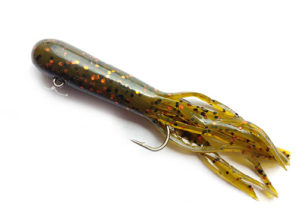
An hour later, with nary a bite, I was rummaging desperately through my tackle box when I spotted my secret weapon: a 4-inch, green tube jig with red flakes. This unsuspecting lure had caught more fish than any lure I own. In no time I was fighting a big ‘ol striper bass to shore…and then 12 more! Amazing! Only one more fish to go: the northern pike.
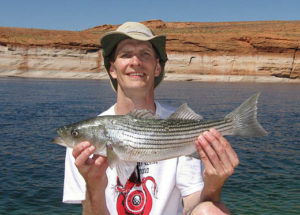
Pike occur in abundance at Yuba Lake in Central Utah, which just happened to be on my way home from Powell. Could I actually do it???
Nope. Runoff was high that year, and the lake was flooded and freezing cold. I wandered all over the limited public access shoreline while tossing everything I had into the water to no avail. Then I went home empty-handed.
2012 was a great year, not because the world didn’t end, but rather I got several days off with my wife for a second round at the northern pike. My goal was simple: Fish all day, every day, and NEVER come home till I’d accomplished my life’s goal.
It was a warm and calm day, the 22nd of May, 2012. We loaded the old green canoe on the roof of my truck and headed south. (NOTE: You definitely need a boat when fishing Yuba. A canoe will work.) We canoed around while tossing spinners into likely pike areas…I think…though I’d never actually seen a pike in reel life. ANYHOO, I got good tug, set the hook, and reeled in a small pike, but a pike nonetheless.
Mission Accompished
I was ecstatic! Well, I was ecstatic for about 2 minutes. After taking pictures however, a deep emptiness set in. It caught me off guard. All I could think was, “Now what!?” I guess I didn’t believe it would actually happen. Now what?

After 30 years, I’d fallen in love with the chase even more than the fish. Each new species was an exciting new adventure. Countless nights I’d stayed up late studying fish behavior and learning new tactics. Each new fish was accompanied by an adrenaline surge and a great sense of accomplishment. And now it was over.
Such is life.
Now What?
I have since set newer, bigger outdoor goals. I probably won’t live long enough to reach them all, but I now understand that it’s the pursuit I love most. Moreover, it’s the people who support your goals and accompany you on your crazy adventures. (Special thanks to my wife, Esther, who supported me whole-hardheartedly through my mad, mad life.)
Without goals we flounder through life and get lazy. Mediocrity sets in. Give me adventure, give me passion, give me conquest, or give me death!
Conclusion – The Art of Zen Fishing
The most valuable single piece of information I gained from my quest is fish Zen. No matter where I fish, I can pretty quickly get a feel for when, where, and what the fish are biting on. As my lure moves through the water I can almost visualize where the fish are and how they’ll respond to it. Infinite knowledge and experience is archived in my subconscious and conscious mind. I make my next cast and retrieve based not on speculation, but infinite data points, some of which I’m not even conscious of. What does it all mean? I’ll never starve. There’s a simple, primal, and invaluable confidence in knowing that you’ll never starve.
Now It’s Your Turn
Now it’s your turn, if you so desire. Utah has 30 game fish species strewn all over the state, and I’ve never met another person who’s caught them all. Close, maybe. So why not try it yourself! Send me any questions you may have and I’ll be glad to help you out. Truthfully, I’m sitting on way too much fishing information to just take it to my grave.
Happy Fishing!


